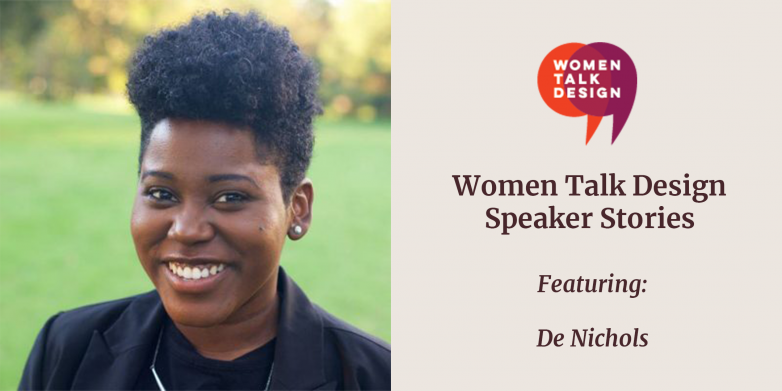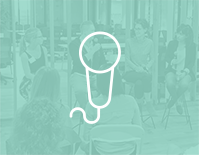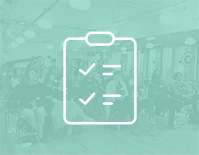De Nichols on using speaking and writing across platforms to amplify your message
As part of our #WTDSpeakerStories, we spoke with De Nichols about her experiences as a speaker and writer, how she draws inspiration, and her strategy for engaging various platforms to create the most ongoing impact on the topics she’s passionate about.
In our Women Talk Design Speaker Stories series, we’re interviewing a Women Talk Design speaker every week about their journeys and experiences. We talk to speakers who are just getting started, speakers who have had their fair share of speaking mishaps, speakers writing books, and speakers curating events. At the end, we offer an opportunity for folks from the WTD community to ask their own questions and connect with each other. Visit our events page for more information about the series and RSVP for our next event.

De Nichols is a designer, social entrepreneur, and keynote lecturer who mobilizes young creative change makers to address issues within the built environment through the production of interactive experiences, digital media, and social initiatives.She’s currently a fellow at Loeb Fellowship at Harvard Graduate School of Design and she serves as Principal of Design & Social Practice at Civic Creatives. Through her leadership with these and other works, Nichols has been deemed a national #IdeasThatMatter recipient, a two-time Clinton Global Initiative innovator, and a St. Louis Visionary for her community impact.
Within her community, De leads as the youngest member of the Board of Directors for Forward Through Ferguson, a non-profit developed to hold the St. Louis region accountable to racial equity following the 2014 murder of Michael Brown. She previously chaired the Board of Directors for Creative Reaction Lab, which educates and equips Black and Latinx youth to foster design-based approaches to racial issues.
On why she speaks and how she started
De told us that speaking is in her blood.
“Part of it is why not? I also feel like speaking is in my bloodstream. I come from a family of lots of ministers, and I’ve been speaking since I was a little kid, starting with the Easter speeches at church, and then having special events like MLK essay competitions.”
“I started as a writer and writing turned to speaking. I started to take it seriously because it was an avenue for me to face my own anxieties about socializing with people, but also realizing that when I did speak, people listened and I actually did have something to say. That sense of reciprocity created a snowball effect of, ‘Yeah, let’s speak at as many conferences as possible. Let’s motivate as many people, let’s use as many platforms.’”
While De’s been on stage since childhood, she has identified a couple key moments that opened her eyes to the possibilities of speaking.
“There used to be an annual Black History Month Speaker Series and I remember submitting [a] speech. I didn’t win that competition to do it in front of the entire student body, but I did get to give that speech at one of the student groups and someone in that audience was so intrigued by that they were like, ‘Yo, you sound like a minister. Do this more.’ And that is the moment like stuck with me and I really believed, ‘Yeah, perhaps, I have a gift [for] this.’”
“The moment that really catapulted my career was when I was invited to join former President Bill Clinton on stage to open up the annual Clinton Global Initiative. And all I had to do is talk about one of my projects that had been accepted into the CGIU for that year. And when I saw the video and I saw people’s response [and] applause to all that I shared about change making with young kids, that was the moment that I was like, ‘Yeah, I can take on large stages. Let’s do this now!’”
On how she finds speaking engagements and how her process has evolved
De said she mainly finds speaking engagements through others who reach out after seeing one of her previous talks, emphasizing the importance of creating an archive of past work.
“A lot of it has come from people reaching out to me. So many of the talks that I’ve given are on a shared playlist, both on my website as well as on YouTube. And so when people search my name or Google my name, they see all these videos of me giving talks. And most of the time, people will join in – either at a conference or at an event – from the audience. [They will] come up to me afterwards and say, ‘Hey, I really enjoyed what you shared. Could you come and do that same thing for my group or for my organization?’”
As her speaking has developed, De talked about how she has started to gravitate to different kinds of opportunities.
“Earlier on, I [thought,] “I’m going to evangelize this message about racial justice and social change everywhere that I can!’ However, in recent years [there’s been] a shift in [my] journey. I’ve really gravitated towards saying yes to things that I haven’t already done because so many of those conversations and talks are now archived – you can easily go onto YouTube and watch me talk about my portfolio or watch me talk about specific projects. And so when I get the opportunity to share something new or have a challenge to think about a different topic from a different perspective, that’s when I get most excited.”
On how she develops talks and finds inspiration
De discussed how she draws on her own life experiences and her research to connect the dots when developing a talk to ensure it resonates with her audience.
“Honestly, it depends on the event. A lot of conferences have an annual theme. Or, if there’s a keynote or a session, that I’m speaking at there’s usually some type of theme around it. And I try to pull from my actual life experiences, not just as a designer, but as a human to speak to that topic. And oftentimes I’ll script it out or at least outline it.”
“But lately it’s been – and I think this is because I am also a lecturer now – I try to find other sources [that go] beyond my own experience, and really dive into research, dive into history, connecting the dots between what the subject or the prompt for the talk is and tying that [together] in a way that becomes a little more universal.”
“[For example,] one of my favorite subjects [is] women changemakers throughout history and Fannie Lou Hamer in particular. There was a conference last year [with] The Association for Community Design and they invited me to [do] a keynote. I decided to use her words, ‘I’m sick and sick and tired of being sick and tired’ as a framework for discussing the urgency of change in our communities and how design can impact them.”
On using speaking and writing across different platforms
De also pointed out that as she has grown as a speaker, she has explored different platforms for her messages. One reason she said she is drawn to different forums is because of the comfort level the mediums afford.
“In recent months, I’ve thought about switching platforms and thinking more in terms of podcasting and being audio only because now, being on screen all the time, there are certain insecurities that come up and so on. Honestly, I think it’s following the space or the platform that makes me feel the most confident, where the focus is on my words and not an obsession on my hair or my style or if I’ve gained weight or anything like that.”
“[Sticky Notes To Self] started [as an] Instagram thing for me to write a sticky note to myself and just share with other people. And what I started to realize is that I would obsess so much over the calligraphy and my own insecurities about my typography skills. [It reached] the point where the message got lost in the overthinking around the production of this three by three square. And what I found most fulfilling was finding the space where I [could] actually break this note down instead of just writing a caption. YouTube became that space for me because I was already vlogging. What it allowed me to do is really test out my own philosophies about different things that were happening in my life.”
De also talked about the importance of exploring different platforms to expand the impact of your message, playing off of the benefits of each to create a bigger impact.
“The difference [between writing and speaking] comes in the delivery. In terms of people really [being able to get] your message, it’s easy to share things that are written -copy and paste, take a quote, make a graphic out of it. But when it comes to a recorded talk, sometimes everyone doesn’t have the ability to find that perfect clip and reshare it or take some audio in and remember it.”
“There are benefits that come to the writing side but in the reverse, we are in the age of video. And so as a speaker, yes, I want every talk recorded because that’s an archive of this and I know that most people won’t read beyond four paragraphs these days. So if I can give them a quick 30 seconds or 15 seconds on a platform that gets the point across, then perhaps that is what helps it share more widely.”
“I don’t [use social media] as much primarily because I overthink way too much. But what I like about it, especially with Instagram, [is that] you can showcase what you have to say in so many ways. You have the reels, you have IGTV, you have your stories, and you have the main profile posts. And I think that allows you to have the flexibility to share different links of your talk or whatever you want to say. You can put in a quick snippet out on reels.You can make it more interactive in your story. You can put the long version of it on your IGTV and really start to engage people in different ways. So I would definitely encourage it.”
De discussed some one her current and upcoming projects as well as how she has been handling transitions in her career, illustrating how the shift has changed her priorities while allowing her to explore more.
“Admittedly, I’ve had to say no to a lot of opportunities for this spring. And part of that was intentionally for me to find a place of focus within this new world. That has meant passing the torch and I’ve enjoyed that process of amplifying and uplifting other folks in my circles, in my communities who are also just as equipped or just as interested in sharing and talking about designing justice and civic issues and the ways in which we can make racial equity a reality. And so that has been an area of topics that I know that I’ll continue to lead discussions on but it feels great to pivot to where I can process what I’ve already been speaking about, and maybe put it into some other formats long term.”
“One of the things that I’m negotiating at this moment with my publishers is creating a podcast series that is related to [The Art of Protest] and to the activists who are featured in the book, so that this isn’t just a one time thing but it really becomes an educational platform for getting people to see the intersections between art and activism.”
On the advice she’d share with new speakers
De shared the advice she has for new speakers, drawing on her personal experience as a speaker and writer.
“Watch other speakers. Going back to the question about rituals, one of the things that I often do when I’m preparing for a keynote is watch the videos – usually TED talks – of other really amazing women. I’ve watched Brittany Packnett Cunningham’s TED talk over and over before so many talks. Same with like Stacey Abrams. I look at all the women who I admire and I watch their videos and I read their content, I read their essays and their books, so that I’m embodying that same energy when I’m on stage. In conversation, sometimes I stutter [and] I get nervous but when I’m on a stage, so much of that goes away. And I think it is [from] equipping myself with the armor before I have to get into the talk.”
“I would encourage [speakers] to not be afraid of writing. There used to be a point where I would try to remember all of my talking points just off the top of my head and that’s a lot of pressure. Some of it goes back to being a child of a minister. I don’t often see my elders with speaker notes, you know. But these days, especially with doing so much stuff through presentation, I’m able to design my decks to give me the visual cues to stay on topic to stay on point.”
“Especially if you’re new, take the opportunity to reach out to other speakers that you admire to get a few insights and tips on what they do to pitch when they’re reaching out to a conference. I often see conference pitches as an opportunity to experiment. So if there’s something that perhaps through your regular wave of work you’re not able to talk about widely, but it’s a curiosity or a passion, that’s an opportunity to start writing these micro-theses around new ideas and testing them out with an audience.”
De also talked about her experience judging conference applications, and highlighted what speakers should do to be noticed.
“With the applications themselves, the biggest flaw that is often in the applications is that people don’t actually answer the question. And so, answer the question and then add your elaborations and examples and the other connections.”
“In addition to just having knowledge on the subject, it is critical to really amplify the folks who have the passion to talk about it and can tie it directly to either lived experiences or connect the dots for other people to perhaps tap into their own shared experiences. But in addition to passion, a different perspective [is important]. Many of us can talk about design. We might be able to talk about challenges that we face in design. But are there any folks who can talk about unique solutions to addressing these issues or propose new ideas? I think those are the things that usually stand out in applications but also from the energy of being in conversation with different speakers as well.”
For more on De’s upcoming book The Art of Protest, how speaking has impacted her career, and her goals for the future, check out the full event video below:

